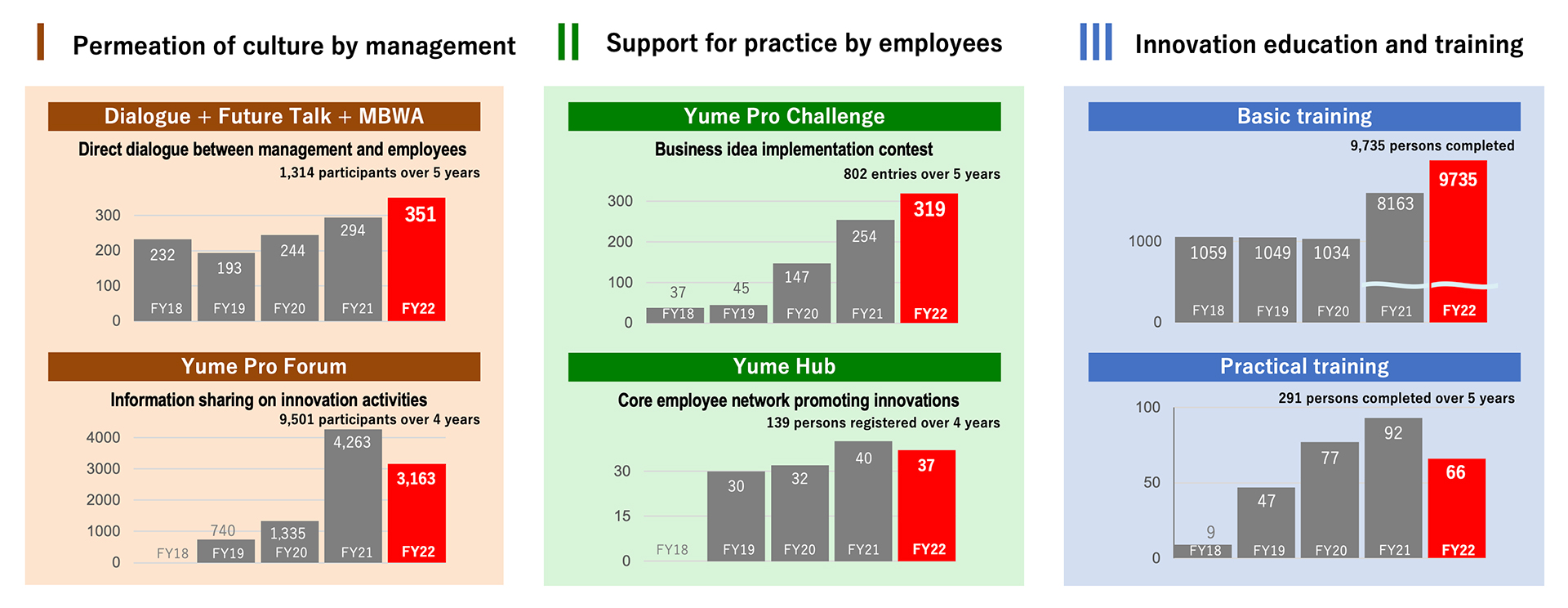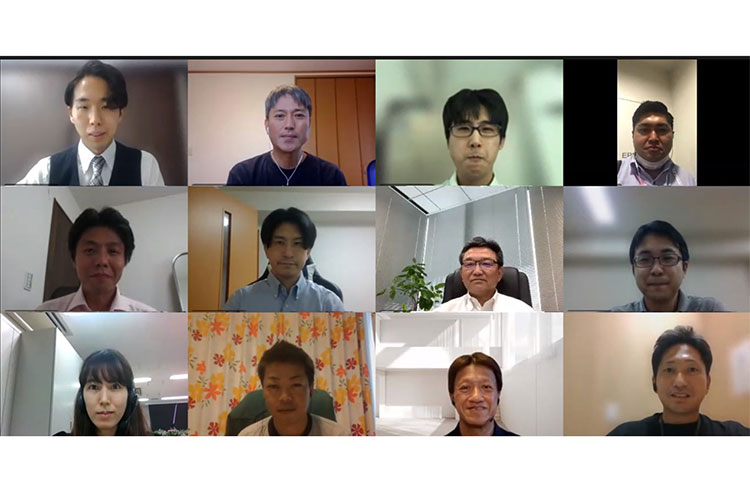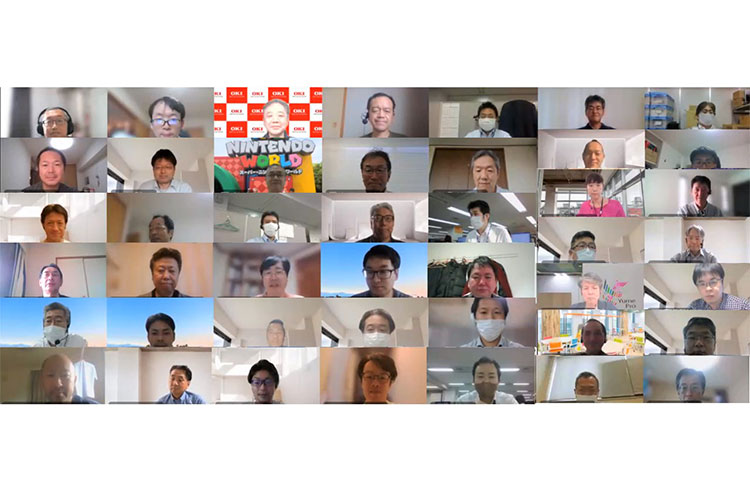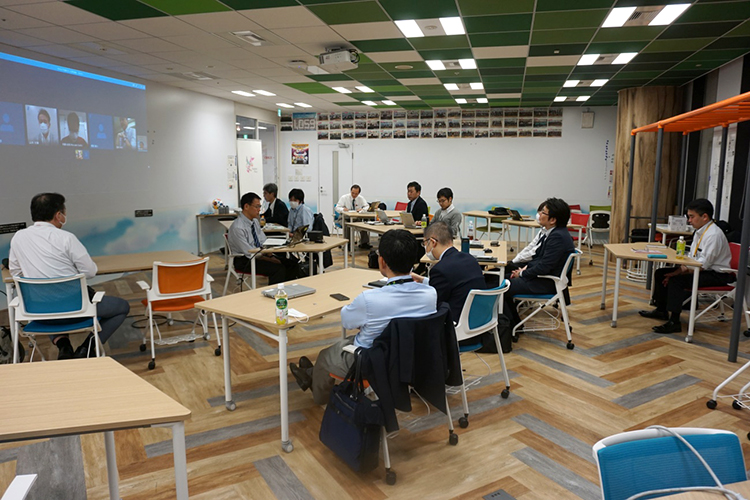OKI aims to be a company where everyone participates to create innovation a common everyday work basis by conducting internal culture reform based on the three main pillars listed below.

Ⅰ. Culture penetration by management
Two activities are carried out for the culture penetration by management.
① Innovation Dialogue
The aim of this event is to directly communicate management's thoughts on innovation to employees by having them engage in casual conversation with managers such as the president and vice presidents, over lunch. The aim is to convey specific thoughts tailored to the concerns of individual employees, which cannot be conveyed through a company-wide president's speech.
This event involves about 10 people at a time, all of who have a common topic to discuss. We have set a wide range of common topics for Yume Pro challenge winners, innovation practice training graduates, product planning leaders, young people in their 20s, and others. Setting a theme makes it easier for participants to converse, rather than having a one-to-many question and answer session with management. We are expecting that many employees will share management's thoughts when they return to their workplaces and share management's thoughts.
Innovation Dialogue has been held 20 to 30 times a year since 2018 without interruption. Previously, we gathered in the innovation room Yume ST to hold face-to-face meetings, however, in response to recent circumstances, we now hold them completely online, or in a hybrid format with a limited number of people. By introducing online support, we are now able to expand our reach by making it easier for employees in rural areas, who previously had difficulty participating, to participate.

② Yume Pro Forum
To promote Full Participation Innovation, we hold lectures to share information on the various innovation activities that are being carried out at various locations within the company.
Previously, the chairman and innovation managers visited different locations in Japan to explain the importance of innovation, however, starting in fiscal 2021, a theme has been set each time to convey the thoughts of those responsible for each innovation activity. After that, we changed the structure to one in which the person in charge explains the specific activities. We disseminate information on the construction status of the innovation management system and each division's innovation initiative policy.
Since 2020, we have switched to online transmission, more than 200 people attend each session, and access to the video archive is also increasing.

Ⅱ. Practical support for employees
We also provide a place to demonstrate and improve the innovation skills acquired through training and lectures.
① Yume Pro Challenge
We hold an internal ideas contest as a vehicle to put the Yume Pro process and BMC (Business Model Canvas) learned during innovation training into practice.
Every year, we receive over 100 applications, and we provide a variety of support mechanisms each year to improve both the quality and quantity of ideas. In particular, starting in fiscal 2020, we have created a system in which an accelerator accompanies each proposed idea and works together to refine the idea. The level of ability required to hone an evidence-based business model has increased significantly, and we now conduct interviews with potential customers as a condition of the first screening.
The grand prize, runner-up prize, special prize, and others are selected at the final screening carried out by management The winning ideas will continue to be accompanied by accelerators and supported by the innovation department to enable them to commercialize the ideas. The grand prize includes approximately 100 million yen aimed at supporting the verification of various hypotheses and the construction of business scenarios. We hope that businesses that support OKI in the future will be created and developed.
② Yume Hub
The purpose is to build a network of innovation core members within the company, expand the scope of innovation activities, and promote internal culture reform. There are already 100 Yume hub members who are active within OKI Group. In fiscal 2021, we collaborates with innovation-related managers established in each division with the aim of solving innovation issues in each department. While deepening their understanding of engineering and IMS and acquiring entrepreneurial mindsets, they conducted workplace assessments, addressed departmental issues, and reflected on each member's activity goals. Through Yume Hub activities, we have achieved results such as creating a system for regional collaboration across departments, supporting idea generation activities, and improving the culture of applying the Yume Pro Challenge.
③ Yume ST
We are building an innovation room as a real "place" to support ideas. Based on the concept of developing an exciting space to generate new ideas, we created Yume ST TORANOMON at our Toranomon headquarters in fiscal 2018. This is a place where we engage in co-creative activities with many partners, and use it as a studio to disseminate compiled information.
In fiscal 2021, we opened Yume ST TAKASAKI in the Takasaki area, OKI's manufacturing base. It was difficult to gather in person due to the coronavirus pandemic, so we are holding online/hybrid meetings.
Ⅲ. Innovation training
To realize "Full Participation Innovation," we are conducting innovation training for all employees of OKI Group.
The Innovation Training offers the following programs that combine e-learning and workshops (currently conducted online), from basics to practice, depending on the objective and individual level.
| Training course | Purpose/Target | |
|---|---|---|
| 1 | Basic training | Learn about the importance of innovation and Business Model Canvas (BMC), and learn how to discover customer problems and build BMC |
| 2 | BMC follow-up training | Learn how to construct and verify the hypotheses using BMC |
| 3 | Practical training for individuals | Learn the process of refining your business scenario by repeatedly verifying your own BMC hypotheses. |
| 4 | Practical training for organizations | Learn the process of refining business scenarios by repeatedly testing hypotheses as a team for product planning themes that are currently being considered by the organization. |
| 5 | SDGs training | Learn how to explore business opportunities related to the SDGs (social issues) and build BMC |
| 6 | Design thinking training | Acquire skills to identify issues and test hypotheses to explore customer value |






